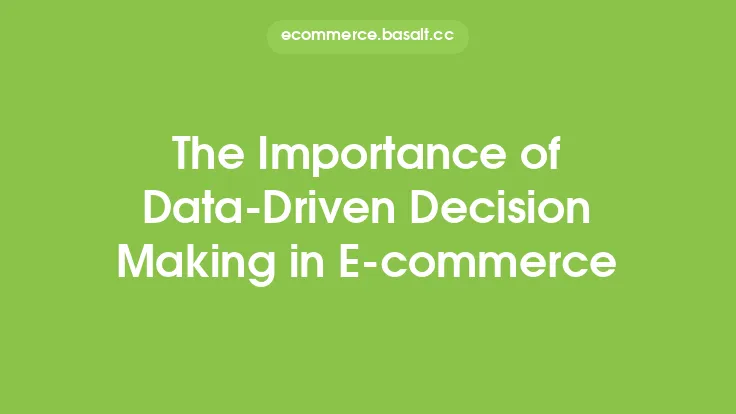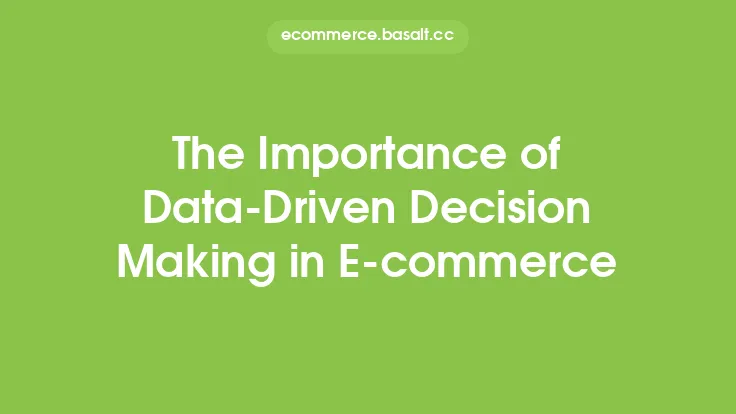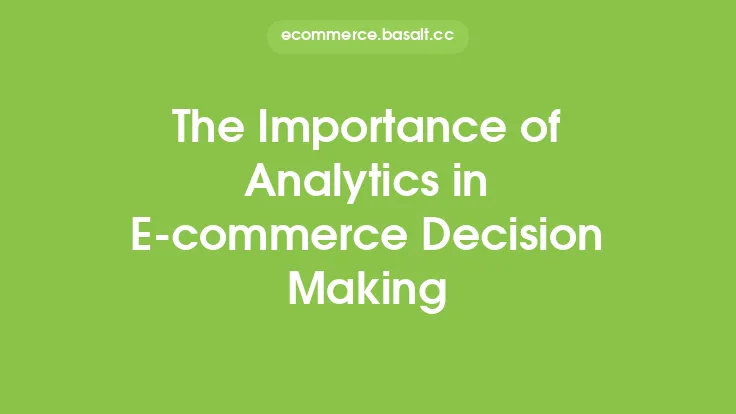In today's fast-paced and competitive e-commerce landscape, making informed decisions is crucial for businesses to stay ahead of the curve. With the vast amount of data available, e-commerce companies can no longer rely on intuition or guesswork to drive their decision-making processes. Instead, they must adopt a data-driven approach to optimize their operations, improve customer experiences, and ultimately drive revenue growth. Data-driven decision making is a methodology that involves using data and analytics to inform and guide business decisions, rather than relying on personal opinions or biases.
What is Data-Driven Decision Making?
Data-driven decision making is a process that involves collecting, analyzing, and interpreting data to gain insights and make informed decisions. In the context of e-commerce, this means using data from various sources, such as website analytics, customer feedback, and sales data, to inform decisions on product development, marketing strategies, and customer engagement. By using data to drive decision making, e-commerce companies can reduce the risk of making mistakes, improve the efficiency of their operations, and increase the likelihood of achieving their business goals.
Benefits of Data-Driven Decision Making in E-commerce
The benefits of data-driven decision making in e-commerce are numerous. Some of the most significant advantages include:
- Improved decision making: By using data to inform decisions, e-commerce companies can reduce the risk of making mistakes and improve the effectiveness of their decision-making processes.
- Increased efficiency: Data-driven decision making can help e-commerce companies streamline their operations, reduce waste, and improve productivity.
- Enhanced customer experiences: By using data to understand customer behavior and preferences, e-commerce companies can create personalized experiences that meet the needs of their customers.
- Better resource allocation: Data-driven decision making can help e-commerce companies allocate their resources more effectively, ensuring that they are investing in the areas that will drive the greatest returns.
- Competitive advantage: In a crowded and competitive market, data-driven decision making can be a key differentiator for e-commerce companies, enabling them to stay ahead of their competitors and achieve their business goals.
Key Components of Data-Driven Decision Making in E-commerce
There are several key components of data-driven decision making in e-commerce, including:
- Data collection: This involves gathering data from various sources, such as website analytics, customer feedback, and sales data.
- Data analysis: This involves using tools and techniques, such as statistical modeling and data visualization, to analyze and interpret the data.
- Data interpretation: This involves using the insights gained from the data analysis to inform business decisions.
- Decision making: This involves using the insights gained from the data analysis to make informed decisions that drive business outcomes.
- Continuous monitoring and evaluation: This involves continuously monitoring and evaluating the effectiveness of the decisions made, and making adjustments as needed.
Best Practices for Implementing Data-Driven Decision Making in E-commerce
To implement data-driven decision making in e-commerce, companies should follow several best practices, including:
- Establishing clear goals and objectives: This involves defining what the company wants to achieve through data-driven decision making, and establishing clear metrics for success.
- Developing a data-driven culture: This involves creating a culture that values data and analytics, and encourages employees to use data to inform their decision making.
- Investing in data analytics tools and technologies: This involves investing in the tools and technologies needed to collect, analyze, and interpret data, such as data visualization software and statistical modeling tools.
- Providing training and support: This involves providing employees with the training and support they need to use data and analytics effectively, such as training on data analysis and interpretation.
- Continuously monitoring and evaluating: This involves continuously monitoring and evaluating the effectiveness of the decisions made, and making adjustments as needed.
Common Challenges and Limitations of Data-Driven Decision Making in E-commerce
While data-driven decision making offers many benefits, there are also several common challenges and limitations that e-commerce companies may face, including:
- Data quality issues: This involves ensuring that the data collected is accurate, complete, and reliable.
- Data integration challenges: This involves integrating data from multiple sources, such as website analytics and customer feedback.
- Limited resources: This involves having the resources needed to collect, analyze, and interpret data, such as personnel and technology.
- Resistance to change: This involves overcoming resistance to change from employees who may be used to making decisions based on intuition or personal opinion.
- Balancing data-driven decision making with intuition: This involves balancing the use of data and analytics with intuition and personal experience, to ensure that decisions are informed by both data and expertise.
Future of Data-Driven Decision Making in E-commerce
The future of data-driven decision making in e-commerce is exciting and rapidly evolving. Some of the trends that are expected to shape the future of data-driven decision making in e-commerce include:
- Increased use of artificial intelligence and machine learning: This involves using AI and machine learning to analyze and interpret data, and make predictions about future trends and patterns.
- Greater emphasis on customer experience: This involves using data to create personalized experiences that meet the needs of customers, and drive loyalty and retention.
- Increased use of real-time data: This involves using real-time data to inform decision making, and respond quickly to changes in the market or customer behavior.
- Greater emphasis on data governance: This involves ensuring that data is accurate, complete, and reliable, and that it is used in a way that is transparent and accountable.
- Increased use of cloud-based data analytics: This involves using cloud-based data analytics to collect, analyze, and interpret data, and make informed decisions.





